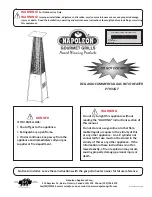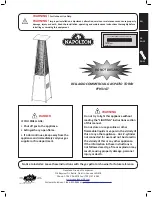
17
EN
GAS CYLINDER CONNECTION AND LEAK
DETECTION
• There may be slight deviations. This is not due to the quality, but is subject
to product improvements.
• The device may only be operated with a liquid gas container of less than
15 kg.
• The pressure regulator must comply with the EN12864 standard. The
hose must comply with the EN1763-1 standard and be no longer than
50 cm.
• Connect one end of the hose to the pressure regulator and the other end
to the tap. Ensure that the connections are tight and that the components
and fittings are not damaged.
• The gas tap must be closed before connecting to the gas cylinder and
there must be no open flames in the vicinity (burning oven, etc.). The seal
must be in good condition. Then screw the pressure regulator to the gas
cylinder.
• Place the pressure regulator on the gas tap. Tighten the nut
counterclockwise.
• Check carefully that no gas comes out of the supply line. Use soapy
water (1 part detergent, 2 parts water). If there is a leak, bubbles will rise.
Tighten the connection more tightly or consult a specialist.
• Place the gas bottle in the container. Make sure that the hose is not kinked
or choked and does not touch any hot parts.
• Hang the door for the gas cylinder chamber (see installation).
• When replacing the gas cylinder, make sure that the gas tap is closed and
that there are no open flames (burning ovens, etc.) or heat sources in the
working area nearby.
• The hose must be replaced every 2 years.
• Check the gas hose once a month and every time the gas cylinder is
changed. If there are signs of cracking, splintering or other damage, the
hose must be replaced.
• Do not tamper with the connections and other components incorrectly.
• Do not turn the gas cylinder upside down to use up the rest of its contents
completely. This will result in the leakage of fluid residues that will
irreparably damage the gas heater.








































